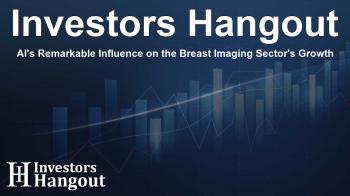AI's Remarkable Influence on the Breast Imaging Sector's Growth

Artificial Intelligence in Breast Imaging: A Transformative Journey
In recent years, artificial intelligence (AI) has emerged as a revolutionary tool across various sectors, particularly in healthcare. One of the most impactful applications of AI is in breast imaging, where it is reshaping diagnostic practices and improving patient outcomes dramatically. Reports indicate that the AI in breast imaging market was valued at USD 423.9 million and is projected to surge towards USD 1,886.4 million by the year 2032. This astounding growth is bolstered by an anticipated compound annual growth rate (CAGR) of 16.1% from 2024 through 2032.
Driving Forces Behind Market Growth
The surge in breast cancer cases worldwide has necessitated more effective diagnostic solutions. As a result, the application of AI in breast imaging presents a viable answer, enhancing the precision of diagnoses and minimizing human error. AI technologies, particularly those utilizing deep learning algorithms in combination with computer-aided detection (CAD) systems, are becoming increasingly widespread in clinical settings.
Innovative Technologies in Breast Imaging
AI's integration into breast imaging has not only facilitated enhanced accuracy but has also streamlined workflow for radiologists. The continuous improvement of cloud-based AI solutions, along with the progression of 3D mammography and automated breast ultrasounds (ABUS), have significantly contributed to this expansion. The healthcare sector is increasingly investing in these advanced technologies, driving demand for novel diagnostic tools.
Key Components Enhancing Diagnostic Accuracy
The software segment is currently leading the market, holding 58% of the share in 2023. This software leverages machine learning algorithms and deep learning models to assist radiologists in identifying anomalies within breast tissue. Studies suggest that AI applications will rise by approximately 25% yearly over the next decade, reflecting a robust trend toward the adoption of these intelligent technologies.
Crucial Applications in Cancer Detection
Focusing on diagnostics, AI's role is pivotal in early detection of breast cancer, a critical factor in improving survival rates. The diagnostic segment's significant market share underscores the urgency for advanced tools to detect potentially cancerous cells rapidly. Projections indicate nearly 300,000 women in the U.S. will battle breast cancer, highlighting the pressing need for more effective diagnostic solutions.
Market Segmentation and End-Users
Hospitals and clinics are the primary end-users within this market, reflecting a significant adoption of AI-based imaging solutions. This growth is propelled by a rising number of diagnostic centers and a preference for non-invasive procedures. Recent reports highlight a 15% increase in AI-capable hospitals across the U.S. within three years, showcasing a trend likely to continue.
Regional Growth Trends
North America holds the largest share of the AI in breast imaging market, accounting for 32% of total market engagement. This dominance is attributed to a robust healthcare infrastructure and a continual investment in research and development. Compellingly, over 60% of newly approved breast imaging devices include AI solutions aimed at facilitating enhanced cancer detection.
Recent Advancements in AI Technology
Several notable advancements in the field lend credence to AI's growing role. IBM Watson Health has recently partnered with healthcare providers to implement AI solutions in clinical workflows aimed at boosting diagnostic accuracy. Furthermore, Google Health's unveiling of an AI-enhanced mammography tool has yielded promising results, with a reported 30% reduction in false positives through early trials.
Looking Ahead
As the healthcare landscape evolves, the demand for AI-driven technologies in breast imaging is likely to increase. The Asia Pacific region is expected to experience substantial growth due to its heightened investments in healthcare and rising clinical awareness about breast imaging technologies. Countries such as China and India are positioned to lead this charge by effectively leveraging their healthcare initiatives.
Frequently Asked Questions
What is the current market value of AI in breast imaging?
The market value is estimated to be USD 423.9 million as of 2023.
What is the projected market size by 2032?
The market is expected to reach USD 1,886.4 million by 2032.
Which technological segment is leading the market?
The software segment is leading the market with a 58% share.
How is AI impacting breast cancer detection?
AI enhances the speed and accuracy of identifying cancerous anomalies in breast imaging.
What role do hospitals play in this market?
Hospitals and clinics are principal users of AI technologies, significantly boosting their integration in diagnostics.
About The Author
Contact Dylan Bailey privately here. Or send an email with ATTN: Dylan Bailey as the subject to contact@investorshangout.com.
About Investors Hangout
Investors Hangout is a leading online stock forum for financial discussion and learning, offering a wide range of free tools and resources. It draws in traders of all levels, who exchange market knowledge, investigate trading tactics, and keep an eye on industry developments in real time. Featuring financial articles, stock message boards, quotes, charts, company profiles, and live news updates. Through cooperative learning and a wealth of informational resources, it helps users from novices creating their first portfolios to experts honing their techniques. Join Investors Hangout today: https://investorshangout.com/
The content of this article is based on factual, publicly available information and does not represent legal, financial, or investment advice. Investors Hangout does not offer financial advice, and the author is not a licensed financial advisor. Consult a qualified advisor before making any financial or investment decisions based on this article. This article should not be considered advice to purchase, sell, or hold any securities or other investments. If any of the material provided here is inaccurate, please contact us for corrections.

